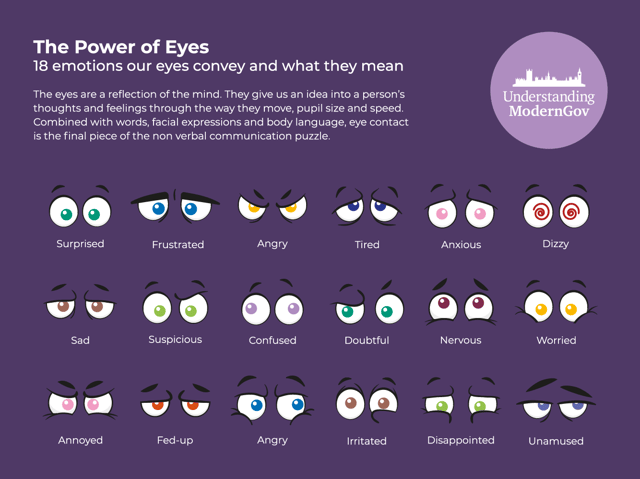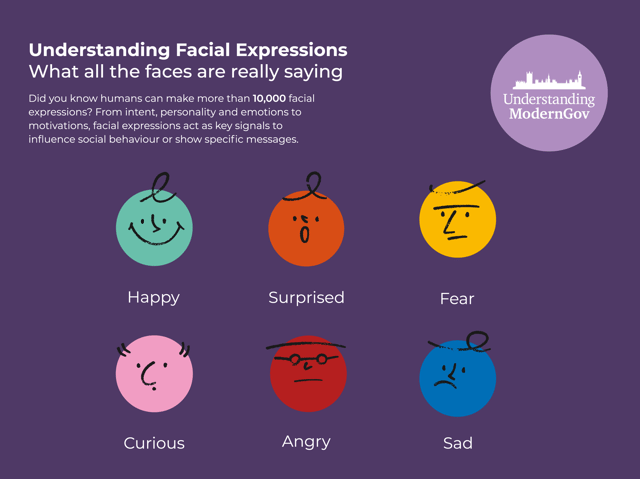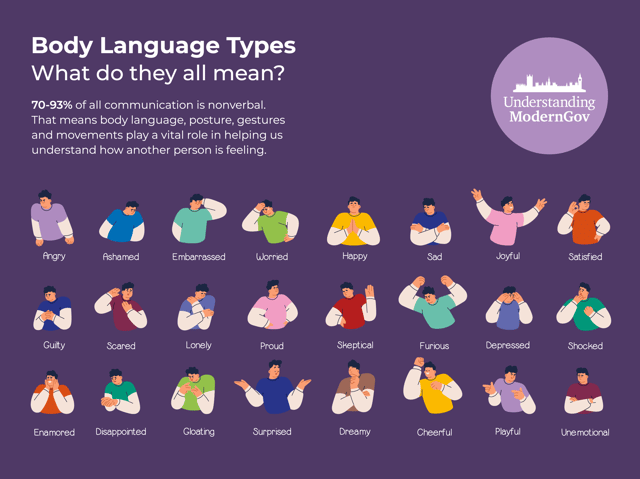The Importance of Body Language in Presentations
 Chloe Martin
·
7 minute read
Chloe Martin
·
7 minute read
All eyes are on you.
Before you’ve even spoken the first word, your audience can already read how you’re feeling through your body language.
Nonverbal cues are the key indicators of your true emotions. If you’re a nervous presenter, this doesn’t work to your advantage, but fear not, as it is a skill that can be taught and mastered with practice.
We’ll dive into the importance of body language in presenting, which nonverbal cues are most important when presenting and what not to do when all eyes are on you. Plus, how to use body language in sit-down presentations.
Contents:
- Why is Body Language Important in Presentations
- 5 Non-Verbal Cues to Think About When Presenting
- What Body Language Not to Use When Presenting
- Body Language Tips to Rock Your Next Presentation
- BONUS: How to Use Body Language for a Remote Presentation
Why is Body Language Important in Presentations?
In simple terms, body language can make or break your presentation.
Anyone can get up on stage and talk. But it’s how you present and use body language to convey your passion and authority that will keep your audience engaged in the long run. Your body language can reinforce your points and guide your audience towards the next stage of your presentation.
Before you’ve even said the first word of your presentation or speech, it’s likely that the audience has already decided whether they trust you or not.
There are lots of different aspects that go into acing your body language. We’ll go over 5 of them in more detail.
5 Nonverbal Cues in Presentations
Body language is heavily influenced by 5 other nonverbal communication cues that you should be aware of in public speaking – trust us, they make a big difference. These include:
Let's get started...
1. Hand gestures
The purpose of hand gestures during a presentation is to make your message clearer, not more complicated. Using the right amount of hand gestures is the key. Overly exaggerated gestures can be distracting but using clear gestures can add impact to your points. For example, using gestures to address certain slides, making contrasts or a numbered list – the combination of visual and audio aids will draw in your audience’s attention.
Show your enthusiasm through controlled and natural gestures, not forced hand gestures that can distract your audience.
2. Eye contact
Have you ever heard someone say, “…you could see the emotion in their eyes”? This isn’t a lie. Human beings portray lots of emotion and feelings in their eyes, so much so that many of us can understand what another person is saying just by eye movements alone. Use the audience’s eyes and body language to gauge their reaction to your presentation – if they look bored, make changes to your tone or try to engage them.
When it comes to eye contact when presenting, aim to use 50% eye contact as you’re speaking and looking around the room intently to show your audience your confidence and interest in the subject. Good eye contact can also help incorporate the audience into your presentation, making them feel part of the process.
If you avoid eye contact, you will come across as nervous. This can make your audience feel uncomfortable and prevent you from forming a genuine connection with your audience.
Top tip: It can be nerve-wracking when the attention is all on you. A common technique often used in public speaking is picking three central spots in the room to focus on. While presenting, look at each spot for 3-5 seconds, and then move onto the next. This gives the illusion that you are making eye contact with the audience without actually doing it.
3. Posture
Presentation posture is all about standing tall, chin up and open arms – never cross your arms. This can be tricky if you’re a nervous presenter. But, if your audience can tell that you’re afraid of them, it’ll be hard to win over their trust and full attention.
Stand with your feet apart, shoulders open and naturally relaxed. This will convey confidence and authority and will invite your audience in, instead of pushing them away. Having good posture will also help you to breathe more easily and project your voice further across the room – particularly useful if you’re presenting to a big group.
Here are some effective body language examples for presentation posture:
4. Movement
X marks the spot. There’s an old myth that every presenter should stand still, feet shoulder width apart and just simply speak – almost like a statue. Now, we see some of the best presenters (whether it be during TED Talks or CEO product launches) walking around the stage with confidence and natural energy. We are human beings after all – it’s not in our nature to simply stand still.
It’s easy to get this confused though. The key is not to walk or pace around as if you’re getting your daily steps in. Instead, walk slowly between your key talking points when describing less important details of your presentation.
Use your movements to punctuate your statements and stop to make an impact. Just be sure to match your movements with your presentation slides in the background so your audience isn’t distracted.
Want more body language examples? View our other post on why body language is important in communication for bonus videos.
5. Facial expressions
We, humans, can make over 10,000 facial expressions. When it comes to presenting, your facial expressions can suggest a lot to your audience. For example, a monotone facial expression can suggest a lack of interest or belief in your own ideas to your audience. If you’re not interested in your own words and ideas, you can’t expect your audience to be.
It’s important to fully utilise the power of facial expressions when presenting. Watch the faces of your audience to get an insight into how they’re feeling as you present – then you can make adjustments to your own expressions to keep them engaged. Also, if your audience is a big one, ensure you exaggerate your expressions so everyone can read your face.
What Body Language Not to Use When Presenting
1. Slouch or look uncomfortable
We get it, presenting isn’t everyone’s cup of tea. But sometimes it cannot be avoided, especially if you hold a senior position in the organisation. Your posture tells a lot more about you than you think. Try to stand up straight, take your arms away from your body and relax your shoulders.
Not only will this make you feel more confident, but it’ll also make you look more confident, and it will tell your audience that you know what you’re talking about giving them a reason to believe you.
Watch this video for an example of a good and bad presentation – see if you can spot the differences! Tag us on Twitter at @UModernGov and tell us what you find.
2. Turn away from your audience
Moving around in the right moments of your presentation can be impactful but be sure to not turn your back on your audience at any point. As 93% of communication is nonverbal, turning your back on your audience means you’ve lost the impact of your nonverbal cues, but you’re also making it difficult for your audience to hear you and understand what you truly mean.
It’s okay to gesture to the screen if you’re talking about a specific presentation slide, but make sure to keep your body language open and turn towards your audience to keep the attention on your point.
3. Use too many/over-exaggerated hand gestures
Although hand gestures can be a great way to show your passion for a subject, using too many or overly extravagant hand gestures can be distracting or even off-putting to some audience members. You don’t want them spending their time calculating which direction their arms are going to go in next – you want them focused on your words and presentation.
3 Body Language Tips for Presentations
- Maintain eye contact – No matter how big or small your audience is, look them in the eye. No, we don’t mean staring so much to creep them out, we mean looking at them every so often to create a bond and ensure they are focused on you and your words.
- Use open body language – Avoid closing yourself off. If you’re standing still and tense, your audience will feel this. Using open body language will help you clearly express your message in a positive professional and natural manner.
- Get advice or record yourself to see how your body language really looks – it can be difficult to know how your body language really comes across when presenting, especially if it’s not something you do often. Ask a friend to help you practice your presentation or record a practice run to help you see how to improve your body language.
Use this helpful graphic to understand the body language you use and how you can improve.
Bonus: How to Use Body Language for a Remote Presentation
Sometimes you might not have the option of conducting a standing presentation. If this is the case, there are things you can do to still promote positive body language to your audience. Sitting down and presenting your ideas or opinions can offer a great chance to be intimate with your listeners. Use this time to engage in natural sharing in a casual and relaxed tone – putting the listeners at ease.
While you might not have the chance to use your full body to show communication, you can still keep your arms open, and back straight, hand gestures natural and use clear facial expressions and eye contact to support your points.
5 Quick Tips for an Effective Remote Presentation:
- Use vocal variety and modulation to increase your personal impact: A monotonous voice is difficult to listen to so ensure that yours is full of vocal colour. Practice by reading out loud and varying tone, emphasis, and pitch and never forget the power of the pause.
- Become an excellent storyteller: Create a narrative for the meeting so that it flows efficiently. Use examples and stories and ask questions to engage your colleagues in order to get buy-in so that you influence effectively.
- Articulate your message with clarity: Ensure that every word can be easily understood by opening your mouth well and using your articulators - tongue, teeth, lips, hard and soft palate - to maintain clarity. Keep your message short and concise to achieve maximum impact.
- Sit "well" and own your space: Ensure your feet are flat on the ground and that your sitting bones are comfortably in the back of the seat. Sitting too close to the screen can come across as being mildly threatening to the viewer. Use gestures with definition, but also with grace.
- Be aware of your physical presentation: Dress appropriately in single-block colours to avoid distraction. Look behind you to ensure the backdrop your colleagues are witnessing is one you want to reveal.
Your Voice and Body Language Go Hand in Hand – Learn How to Combine The Two Effectively
Now you’ve got your body language in check, it’s time to make sure your words follow suit. Take a look at our upcoming Confidence & Resilience training courses to present the maximum impact.










